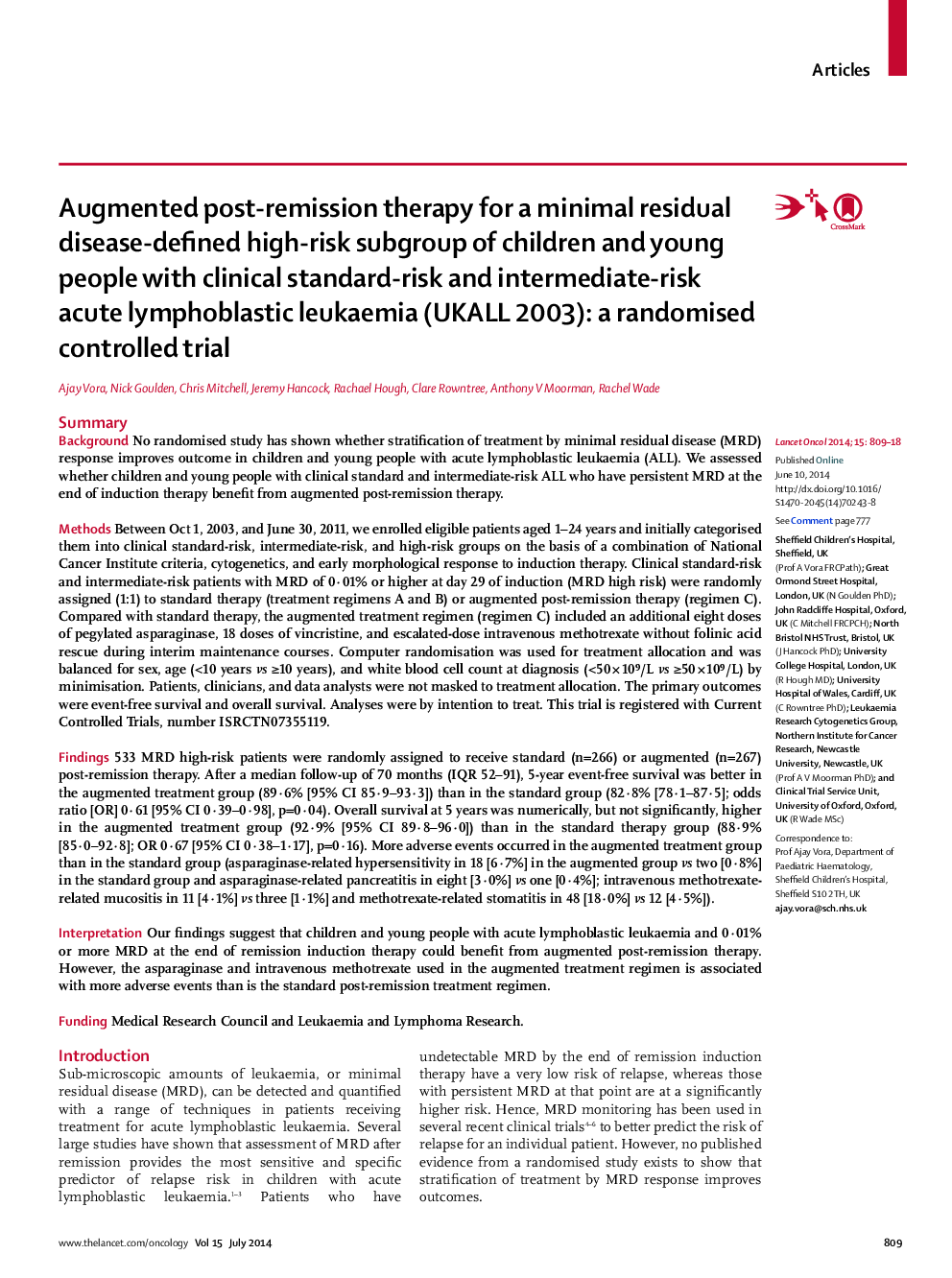| کد مقاله | کد نشریه | سال انتشار | مقاله انگلیسی | نسخه تمام متن |
|---|---|---|---|---|
| 3994419 | 1258889 | 2014 | 10 صفحه PDF | دانلود رایگان |

SummaryBackgroundNo randomised study has shown whether stratification of treatment by minimal residual disease (MRD) response improves outcome in children and young people with acute lymphoblastic leukaemia (ALL). We assessed whether children and young people with clinical standard and intermediate-risk ALL who have persistent MRD at the end of induction therapy benefit from augmented post-remission therapy.MethodsBetween Oct 1, 2003, and June 30, 2011, we enrolled eligible patients aged 1–24 years and initially categorised them into clinical standard-risk, intermediate-risk, and high-risk groups on the basis of a combination of National Cancer Institute criteria, cytogenetics, and early morphological response to induction therapy. Clinical standard-risk and intermediate-risk patients with MRD of 0·01% or higher at day 29 of induction (MRD high risk) were randomly assigned (1:1) to standard therapy (treatment regimens A and B) or augmented post-remission therapy (regimen C). Compared with standard therapy, the augmented treatment regimen (regimen C) included an additional eight doses of pegylated asparaginase, 18 doses of vincristine, and escalated-dose intravenous methotrexate without folinic acid rescue during interim maintenance courses. Computer randomisation was used for treatment allocation and was balanced for sex, age (<10 years vs ≥10 years), and white blood cell count at diagnosis (<50 × 109/L vs ≥50 × 109/L) by minimisation. Patients, clinicians, and data analysts were not masked to treatment allocation. The primary outcomes were event-free survival and overall survival. Analyses were by intention to treat. This trial is registered with Current Controlled Trials, number ISRCTN07355119.Findings533 MRD high-risk patients were randomly assigned to receive standard (n=266) or augmented (n=267) post-remission therapy. After a median follow-up of 70 months (IQR 52–91), 5-year event-free survival was better in the augmented treatment group (89·6% [95% CI 85·9–93·3]) than in the standard group (82·8% [78·1–87·5]; odds ratio [OR] 0·61 [95% CI 0·39–0·98], p=0·04). Overall survival at 5 years was numerically, but not significantly, higher in the augmented treatment group (92·9% [95% CI 89·8–96·0]) than in the standard therapy group (88·9% [85·0–92·8]; OR 0·67 [95% CI 0·38–1·17], p=0·16). More adverse events occurred in the augmented treatment group than in the standard group (asparaginase-related hypersensitivity in 18 [6·7%] in the augmented group vs two [0·8%] in the standard group and asparaginase-related pancreatitis in eight [3·0%] vs one [0·4%]; intravenous methotrexate-related mucositis in 11 [4·1%] vs three [1·1%] and methotrexate-related stomatitis in 48 [18·0%] vs 12 [4·5%]).InterpretationOur findings suggest that children and young people with acute lymphoblastic leukaemia and 0·01% or more MRD at the end of remission induction therapy could benefit from augmented post-remission therapy. However, the asparaginase and intravenous methotrexate used in the augmented treatment regimen is associated with more adverse events than is the standard post-remission treatment regimen.FundingMedical Research Council and Leukaemia and Lymphoma Research.
Journal: - Volume 15, Issue 8, July 2014, Pages 809–818